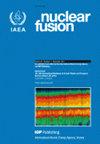Pedestal Main Ion Particle Transport Inference through Gas Puff Modulation with Experimental Source Measurements
IF 3.5
1区 物理与天体物理
Q1 PHYSICS, FLUIDS & PLASMAS
引用次数: 0
Abstract
Transport in the DIII-D high confinement mode (H-mode) pedestal is investigated through a periodic edge gas puff modulation (GPM) which perturbs the deuterium density and source profiles. By using absolutely calibrated experimental edge ionization profile measurements, radial profiles of diffusion (D) and convection (v) are calculated into the pedestal region without depending on modeling the edge ionization source. An analytic approach with closed-form expressions for the D and v profiles and a more advanced Bayesian approach show evidence of an inward particle convection on the order of 1 m s−1 extending to normalized poloidal flux (ΨN) of 0.98. Meanwhile, diffusion reaches a minimum value of (0.03 ± 0.02) m2 s−1 in the pedestal region. Notably, the Bayesian approach, which utilizes the Aurora 1.5 D forward model inside the IMPRAD OMFIT module, provides radially resolved transport profiles with associated uncertainty without requiring an explicit form for the perturbation to the density profile or source. The combination of experimental ionization measurements and Bayesian inference provides an enhanced robust framework for investigating edge particle transport coefficients to experimentally test transport physics in order to improve predictive capabilities in the tokamak edge.通过实验源测量的气体喘振调制推断台式主离子粒子输运
通过扰动氘密度和源剖面的周期性边缘气体脉冲调制(GPM),研究了 DIII-D 高约束模式(H 模式)基座中的输运。通过使用绝对校准的实验边缘电离剖面测量值,计算了进入基座区域的扩散(D)和对流(v)径向剖面,而无需依赖边缘电离源建模。利用 D 和 v 剖面闭式表达的解析方法和更先进的贝叶斯方法显示,粒子对流的数量级为 1 m s-1,延伸到归一化极性通量 (ΨN) 0.98。同时,基座区域的扩散达到了 (0.03 ± 0.02) m2 s-1 的最小值。值得注意的是,贝叶斯方法利用了 IMPRAD OMFIT 模块中的 Aurora 1.5 D 正演模型,提供了径向分辨的传输剖面和相关的不确定性,而不需要密度剖面或源的扰动的明确形式。实验电离测量和贝叶斯推断相结合,为研究边缘粒子输运系数提供了一个增强的稳健框架,以实验测试输运物理学,从而提高托卡马克边缘的预测能力。
本文章由计算机程序翻译,如有差异,请以英文原文为准。
求助全文
约1分钟内获得全文
求助全文
来源期刊

Nuclear Fusion
物理-物理:核物理
CiteScore
6.30
自引率
39.40%
发文量
411
审稿时长
2.6 months
期刊介绍:
Nuclear Fusion publishes articles making significant advances to the field of controlled thermonuclear fusion. The journal scope includes:
-the production, heating and confinement of high temperature plasmas;
-the physical properties of such plasmas;
-the experimental or theoretical methods of exploring or explaining them;
-fusion reactor physics;
-reactor concepts; and
-fusion technologies.
The journal has a dedicated Associate Editor for inertial confinement fusion.
 求助内容:
求助内容: 应助结果提醒方式:
应助结果提醒方式:


